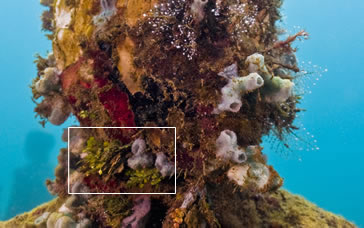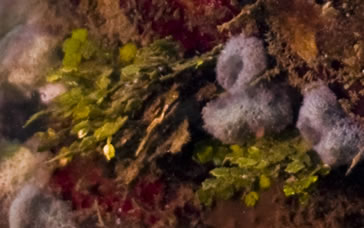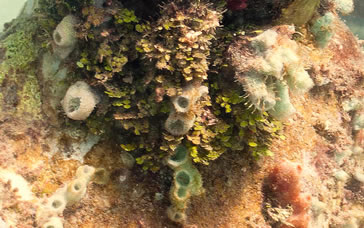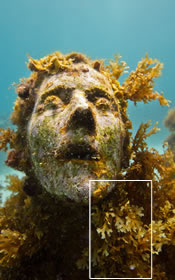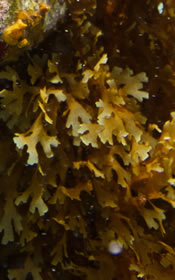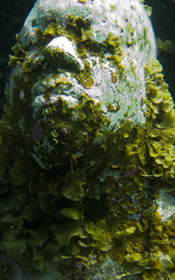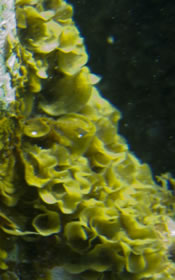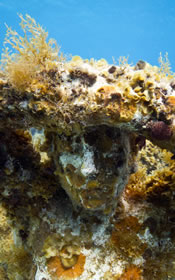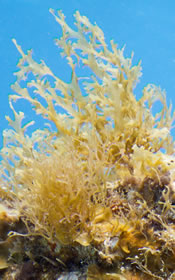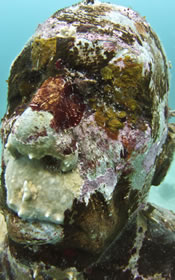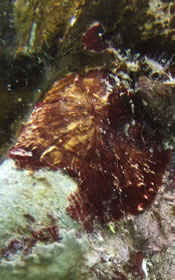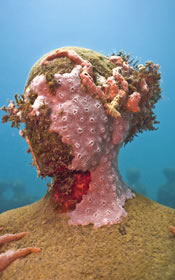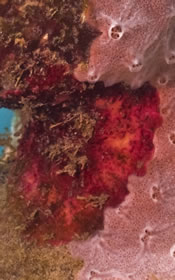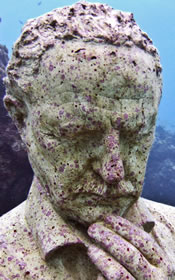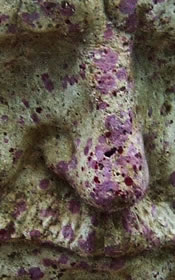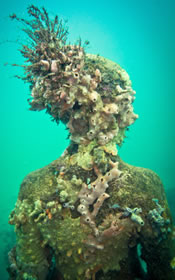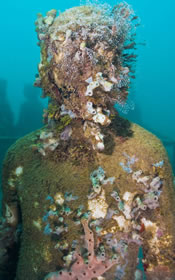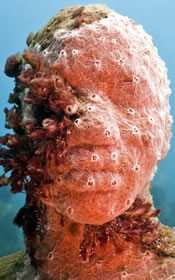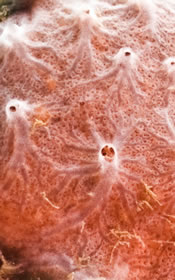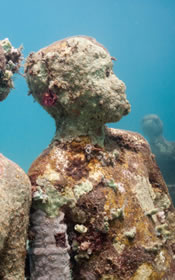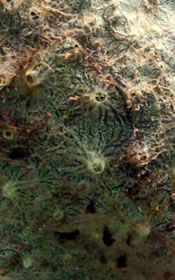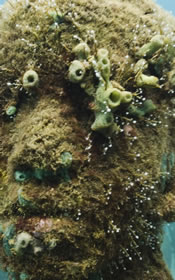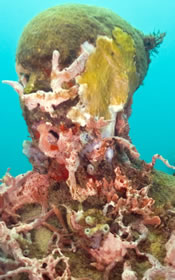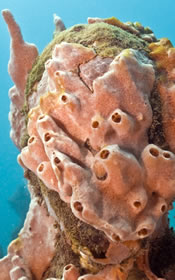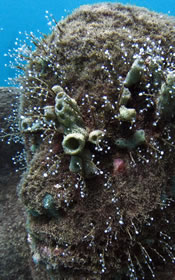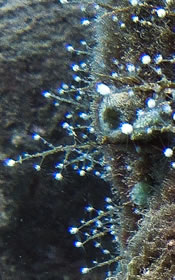- Green Algae: Phylum: Chlorophyta
- Brown Algae: Phylum: Phaeophta
- Red Algae: Phylum: Rhodophyta
Algae are simple structured autotrophic organisms, some are unicellular while others multicellular and most photosynthesis like plants. Algae date back over billion years and some of the first plants on earth evolved from algae. Green algae are by far the most complex group and have led to the evolution of land plants. Their simple structure means they are lacking many anatomical structures that true plants have, specifically organs. Algae do not have true roots but attach to the substrate by rhizoids and rhizomes.
Some species, particularly brown algae, contain gas bladders to keep them afloat. Some algae have a symbiotic relationship with its host so that the photosynthetic products are used by the host for energy, while e the host protects the alga. In a coral reef structure these are primarily algae of the Dinoflagalatte phylum and the alga living endosymbiotically with the stony corals are called zooxanthellae. The loss of this algae is what is known as ‘coral bleaching’
“Reef Coral Identification” by Paul Humann, Ned DeLoach
Green Algae
The most abundant and commonly recognised algae on tropical reefs is the green algae. There are many species and most are calcareous, contributing a large amount of calcium carbonate to the reef building process. These plants form the base of the ocean food chain by carrying out photosynthesis. Chlorophyll is the pigment that forms their various shades of green colour from bright Kelly green to yellow and brown-green to Dark green.
The picture of “Vicissitudes” is suspected to show a variety of Hanging Vine Green Algae growing on it.
Genus: Halimeda sp.
Typically they appear as a flexible string of flattened leaf-like structures often referred to as segments. Each segment is a deposit of calcium carbonate covered by the algal protoplasm and connected to its neighbours by a thin strand, giving the plant its flexibility.
They are fast growing and decorative and the calcified leaves are an integral component as the major contributor of calcium carbonate to the reef sand.
“Reef Coral Identification” by Paul Humann, Ned DeLoach
Branched Brown Alga: Dictoyota sp. on “The Silent Evolution“
Encrusting Fan Leaf Alga: Lobophora variegata on “The Silent Evolution“
Serrated Strap Alga: Dictyota ciliolata on “The Silent Evolution“
Brown Algae
Leafy flat blade Brown Alga: Lobophora sp.
Serrated Strap Brown Alga: Dictoyota sp.
Y Branched Brown Alga: Dictoyota sp.
Brown algae grows into abundant coverage, often in shallow waters. They are multicellular organisms and generally bushy plants formed by blunted blades, often irregularly branched. Some kelps can grow up to 60metres long and the most abundant species of algae is seaweed. The different species come in various shades of yellow-green-brown and often tints of iridescent. The pigment Fucoxanthin gives brown algae various shades or brown-yellow, creamy brown, green-brown to dark brown.
“The Silent Evolution” shows a variety of brown algal species growing as the colonisation of the reef begins.
“Reef Coral Identification” by Paul Humann, Ned DeLoach
Crustose Coralline Alga: Rhodaophyta sp. on “Man on Fire“
Crustose Coralline Alga: Rhodaophyta sp. on “Vicissitudes“
Early colonisation of Crustose Coralline Alga on “The Dream Collector“
Red Crustose Coralline Algae
Phylum: Rhodophyta
Red algae is often abundant but difficult to recognise due to dull colouration and simple encrusting growth patterns yet they are the most diversified with over 5,000 tropical species. Many are calcareous (secrete calcium carbonate) species and play an important role in coral reef construction. They range from dull red to purple to dark brown-red colouration, the red pigment phycoerythrin is responsible. Most red algae are multicellular and undergo sexual reproduction unlike some of the other groups. Coralline algae prefer shade and encrust solid substrates. Colonies can be brittle and hard to distinguish from one another.
Examples are that found on the nose of “Man on Fire” and “Vicissitudes girl“.
“Reef Coral Identification” by Paul Humann, Ned DeLoach

Sponges (Porifera)
Sponges are sessile bottom dwelling filter feeding animals. They attach to a solid substrate and are one of the simplest multi-cellular animals in the marine environment. Their bodies consist of a gelatinous layer (mesophyl) with a thin layer of cells either side. The mesophyl acts as an endoskeleton and encrusts onto rock surfaces. The scientific name for them is Porifera meaning “pore bearing” or Ostia. The network of Ostia channel into an internal system of canals and converge into one or more larger holes called the Oscula. The channels function to move water through the sponge using specialised cells with whip-like fronds to bring Oxygen and nutrients in while filtering food particles and removing waste products via diffusion. Most sponges are hermaphroditic and do not have distinct nervous, digestive or circulatory systems.
Sponges are Encrusting (typically over rock surface) or Free-standing (eg Barrel Sponges can grow to over 6 feet) and the typical shape is that of a vase, however there growth patterns vary hugely. They range in a variety of colours and may live for over 200 years in tropical waters and exceed depth of 8000 metres. Demosponges consist of 90% of sponge species. They use demospongin to strengthen the mesophyl layer. Calcareous sponges with calcium carbonate spicules or even an exoskeleton are only found in shallow waters.
Symbioses: Some species have evolved symbiotic relationships. Photosynthesising microorganisms (often green algae or cyanobacteria)can live on and in sponges forming a mutualistic relationship. Crabs , lobsters, starfishes, reef fishes, worms, crinoids, sea cucumbers live on and attach for camouflage and for a food source, while sponges in turn grow upon and through other organisms. Most species of sponges feed on bacteria and food particles in the water a few have evolved to be carnivorous.
“Snorkelling Guide to Marine Life” by Paul Humann, Ned DeLoach
Demospongiae sp. on “Vicissitudes Boy“
Green coloured sponge: Demospongiae sp. on “Vicissitudes Boy“
Encrusting Sponges
Kingdom: Anamalia
Phylum: Porifera
Class: Demospongiae
These are the largest class of Sponges, including over 90% of species and are abundant and diverse in shallow non-polar waters. Their skeletons consist of the protein Spongin or the mineral Silica (or both) forming “spicules”. The majority are Lueconoid in structure which are the most complex of anatomy of the sponges. They consist of more than 2 million chambers and over 80,000 intake canals to increase the efficiency at which absorption of nutrients takes place. Demospongae come in a variety of colours and body shapes. They asexually reproduce via budding or the productions of gemmules.
Both of these photographs are thought to be of the family Dictyodendrillidae, and an Igernella sp. They are of two sculptures making up “Vicissitudes” in Grenada, West Indies taken 4 years after installation. The 26 sculptures in the ring also have large tubular projections of the sponge extending towards the sea surface from the structure.
“Snorkelling Guide to Marine Life” by Paul Humann, Ned DeLoach
Tubular Sponges
Family: Callyspongia
One of the most common colonies of demospongae found on the reef and distinguished by its long tubular growths or an overall vase shape. The projections resemble antlers protruding in shallows but they are found living at varying depths. Filtered water is ejected through the large openings on the ends of the antlers They range in color from pinks to purple to blue, gray, and gray-green. This is one of the few reef invertebrates that can be blue in color.
The Photographs of the tubular sponges and the pink branching sponge are thought to be of the family Callyspongia, found only reef’s and are very common in the Caribbean. They have grown very rapidly and distorted the face of most of the sculpture in the ring of “Vicissitudes“.
“Snorkelling Guide to Marine Life” by Paul Humann, Ned DeLoach
coralpedia.bio.warwick.ac.uk/en/sponges/callyspongia_plicifera.html
www.wetwebmedia.com/sponges.html
en.wikipedia.org/wiki/File:Callyspongia_sp._(Tube_sponge).jpg
Hydrozoans
Phylum: Cnidaria
Class: Hydrozoa
Order: Hydroida
Related to coral and Jelly Fish. They are small predatory colonial animals that are often confused as plants and grow on benthic strata (rocks and pilings). Each individual hydroid animal are zooids composed of stem pedicles and a flower-like head containing a mouth and tentacles, with multiple polyps connected together by tubular forms called hydrocauli making individuals of the colony interconnected. The polyps are designed for feeding and initial digestion within its central cavity. Some polyps within a colony are designated to reproduction. The hydrocaulus anchors the colony to the substrate like a root and distributes left over nutrition to the rest of the colony. The colonies are generally small and present a fan-like appearance. Many obtain their nutrition from endosymbiotic algae and dissolved particles from the reef and parasites. In return they provide CO2 to algae and plants. Hydra as pictured on Vicissitudes are different to the rest of the phylum and they miss out the Medusoid stage of the lifecycle therefore remaining as polyps for their entirety.
Fire Coral is not technically a coral but a colony of hydroids.
“Snorkelling Guide to Marine Life” by Paul Humann, Ned DeLoach

